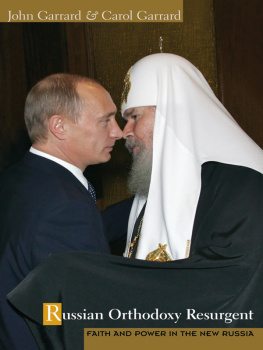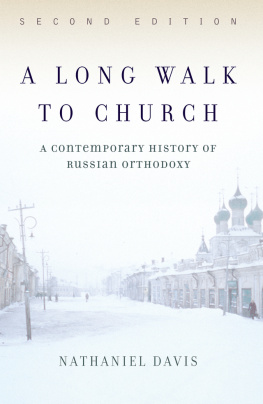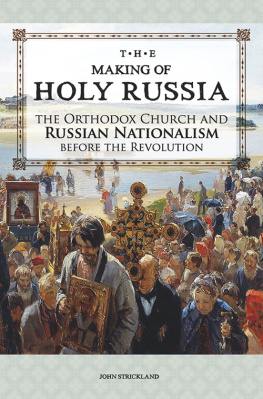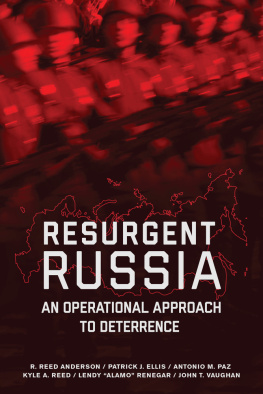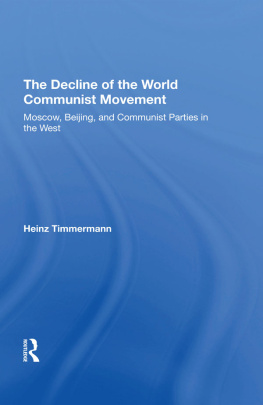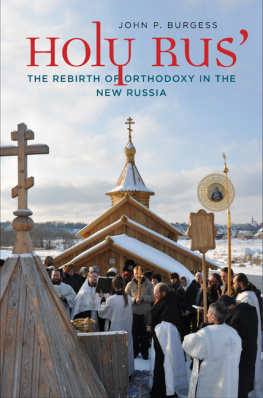
RUSSIAN ORTHODOXY RESURGENT
RUSSIAN ORTHODOXY RESURGENT
Faith and Power in the New Russia
John Garrard&Carol Garrard
PRINCETON UNIVERSITY PRESS
PRINCETON AND OXFORD
Copyright 2008 by Princeton University Press
Published by Princeton University Press, 41 William Street, Princeton, New Jersey 08540
In the United Kingdom: Princeton University Press, 3 Market Place, Woodstock, Oxfordshire OX20 1SY
All Rights Reserved
Library of Congress Cataloging-in-Publication Data
Garrard, John Gordon.
Russian Orthodoxy resurgent : faith and power in the new Russia / John Garrard and Carol Garrard.
p. cm.
Includes bibliographical references (p. ) and index.
ISBN 978-0-691-12573-2 (cloth : alk. paper) 1. Religion and politicsRussia (Federation)History20th century. 2. Religion and politicsRussia (Federation) History21st century. 3. Russkaia pravoslavnaia tserkovInfluence. 4. Russkaia pravoslavnaia tserkov. 5. Aleksii II, Patriarch of Moscow and All Russia, 1929 I. Garrard, Carol. II. Title.
BL65.P7G37 2008
281.947090511dc22 2008005415
British Library Cataloging-in-Publication Data is available
This book has been composed in Electra
Printed on acid-free paper.
press.princeton.edu
Printed in the United States of America
1 3 5 7 9 10 8 6 4 2
To the memory of
John Simmons and Sir Julian Bullard
Patriots and Scholars
The three most importantly innovative and transformative political developments of the last twenty years [have been] the rise of the Christian right in America, the explosion of Islamic fundamentalism in Iran, and the collapse of Communism in the Soviet Union.
James Billington, Librarian of Congress, from the 1997 Templeton Lecture
Contents
Illustrations
Preface
The official dissolution of the USSR on December 25, 1991, occasioned self-congratulation among some in the West but provoked an agony of conscience and recrimination within Russia itself. With huge sections of the country poisoned by chemicals, fresh evidence mounting of the contempt with which the Soviet government treated its own citizens, and the list of those who died in the Gulag growing by millions, Russians faced a period of disorienting turmoil as they saw their truncated country plummet from superpower status. The almost instantaneous disintegration of the Soviet system and the Communist Party that ran it left a vacuum once occupied by the official ideology of scientific atheism.
The Russian Orthodox Church (ROC) is filling this vacuum and reconstituting a national belief system in its own image. Believers are replacing party members. The story of the Russians recovery of their sense of themselves as a great nation (derzhava) is still in progress; its events are being recorded in newspaper headlines and television bulletins. Whatever the outcome, the key role played by the ROC has already recast the country we once thought we knew into a power whose motivations we understand very little. Orthodox believers now constitute the largest volunteer movement inside the Russian Federation during the zero yearsthe Russians own term for the period since 2000. Two powerful trends are converging: one emanates up from the grass roots, and the other is directed down from the Moscow Patriarchate. In an important switch from the situation obtaining in the late tsarist period, those attracted to the church include not only the stereotypical kerchiefed little old ladies (babushki, grandmothers) but also the Russian military and the political, scientific, cultural, and financial elites.
We backed into this critically important topic while editing World War 2 and the Soviet People (1993) and researching and writing The Bones of Berdichev: The Life and Fate of Vasily Grossman (1996). In 1992 we landed at Sheremetievo Airport laden with more than twenty crates of medical aid assembled by the congregation of Our Saviours Lutheran Church in Tucson, Arizona, and the donations of many other ecumenical groups. We intended to distribute this aid both to those Jews who wished to leave Russia and to an ROC congregation and school that we had learned about from the librarian at our daughters elementary school. Our two girls had also led a drive to collect toys, school supplies, and other items for the church children. Thanks to American Airlines and Lufthansa, we flew to Moscow without paying any overweight penalty. It took so long to get the enormous containers of aid through Russian customs that the cavernous waiting room was almost empty when we entered, shepherding a long line of metal trolleys lumbering unsteadily beneath their loads. In one corner waited a greeting committee from Operation Exodusa huddle of young men in keppas from Moscow Universitys newly established Hillel (a student group). They kept casting sidelong glances to the other corner of the waiting rooman equally mystified and tense circle comprised of a Russian Orthodox priest (Father Sergy Romanov) with a luxuriant black beard, several deacons, and a few young Orthodox nuns. Over the anxious and puzzled heads of both groups hung the unspoken question, Can they be waiting for the same people we are? It was a window into the stresses pulling at the substrata of the new Russia.
As we helped this Orthodox congregation restore an eighteenth-century Russian Orthodox Church building, our research began to segue from the Holocaust in the occupied Soviet Union to the revival of Orthodoxy. Indeed, the history of this single church and its courageous priest, Father Sergy Romanov (no relation to the tsarist family), informs the whole subject. This personal engagement led Carol Garrard to publish an article, Religion: From Official Atheism to Freedom of Choice, in an anthology Re-Emerging Russia: Search for Identity (1995), sponsored by Older Americans Service and Information System (OASIS), an innovative and imaginative organization headquartered in St. Louis. The anthology was the basis for a ten-part forum taught in dozens of cities and towns nationwide.
In spite of lively interest from the public, most Western academics, with important exceptions, neglected the churchs resurgence. Political scientists and historians prefer to study the new Russia through the traditional secular lens of economics, politics, demography, and other social sciences. Orthodox theologians here in the West, or the memoirs of believers who suffered mistreatment, can hardly be objective. There are, however, distinguished historians in the West, led by James Billington, the librarian of Congress, who have written perceptively in this field. Billingtons The Icon and the Axe: An Interpretive History of Russian Culture (New York: Knopf, 1966) is essential background to any work on this subject. Further, through an amazing coincidence, he happened to be in Moscow when the August 1921, 1991 coup by KGB and party hard-liners was attempted. His memoir, Russia Transformed: Breakthrough to Hope, is a first-person account that should not be missed. William Brumfield, professor at Tulane University, has produced a magisterial History of Russian Architecture, which contains photographs of literally thousands of Russian Orthodox churches, together with his uniquely informed commentary. The J. M. Dawson Institute of Church-State Studies at Baylor University and the Kennan Institute of the Woodrow Wilson International Center for Scholars in Washington, D.C., supervise innovative research and organize excellent conferences on the Orthodox faith and civic life in Russia. Baylor University Professor Wallace Danielss
Next page
